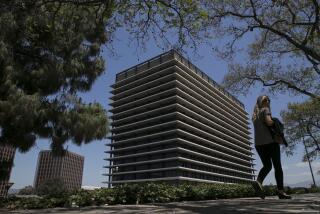DWP Agrees Not to Build Power Station at Controversial Site
- Share via
In a victory for community residents, the Los Angeles Department of Water and Power has agreed not to build an electrical distributing station at an Arleta site opposed by scores of neighbors.
The proposed site in the 13200 block of Branford Street “has been removed from consideration,” DWP spokeswoman Lucia Alvelais said Friday.
“We’re extremely happy,” said John Maxon, president of the Arleta Chamber of Commerce and a leader in the bitter, yearlong fight to block use of the Branford Street location.
DWP officials made the concession Thursday night at the first meeting of a joint community and DWP committee seeking a mutually acceptable site for the new station.
Bowing to pressure from local residents and political leaders, the DWP last spring agreed to form the site committee and conduct a thorough environmental study before going ahead with the project.
Earlier this week, however, as the committee’s first meeting loomed, City Councilman Ernani Bernardi wrote department officials to urge that they “officially and irrevocably delete” the Branford Street site from consideration.
The residents, Bernardi said, feared that Branford remained the DWP’s “only acceptable choice and that any study of other sites is a smoke screen.”
Abandonment of Branford marks a striking change in DWP siting strategy in Arleta and elsewhere. Applying the lessons of Arleta, DWP officials recently decided to consult community leaders and residents in Sherman Oaks and West Los Angeles before choosing sites for new distributing stations in those areas.
“It sounds so simple. You go in there and ask them what they want, . . . but this is nothing that we’ve done traditionally,” Alvelais said.
“I’d like to feel that we’ve learned from our past experiences.”
In the case of Arleta, the DWP not only picked the Branford site but also optioned the land without consulting residents. Officials also said they would dispense with an environmental impact study--despite public fears of possible health risks from electromagnetic fields.
Now, the turnabout seems complete. The DWP has even hired a consensus planning firm, at a cost of up to $48,000, to work with the committee to find a new site.
The committee’s next meeting is planned in December. Groundbreaking for the $9-million station has been delayed until 1993.
Citywide, there are about 130 distributing stations, which transform high-voltage current into lower-voltage power for use by nearby houses and businesses.
The Arleta controversy started as a zoning dispute, with residents worried that the station would bring commercial development to a neighborhood of modest, single-family houses.
The battle later came to reflect nationwide concern about potential cancer risks from electromagnetic fields (EMF), invisible lines of force that radiate outward from any equipment or device that carries electric current.
A number of studies have found a small increase in cancer rates among children living near high-current power lines and among workers in electrical occupations, such as utility linemen and film projectionists. A smaller number of studies have shown no such relationship, and scientists generally say a causal link between EMF and cancer has not been proven.
Field strengths fall off sharply with distance from the source, and DWP officials say distributing stations do not raise EMF exposures of nearby residents.
More to Read
Sign up for Essential California
The most important California stories and recommendations in your inbox every morning.
You may occasionally receive promotional content from the Los Angeles Times.













